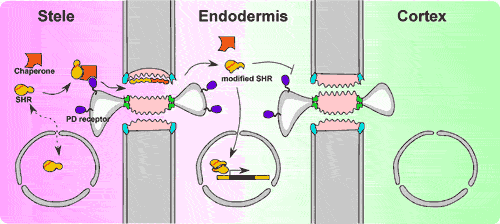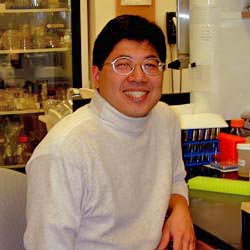

|
|||
|
|||
| SHR as a Model System to Study the Regulation of Cell-to-Cell
Trafficking in Plants |
|||
| Tien-Shin Yu and William J. Lucas | |||
| Section of Plant Biology, University of California, Davis, USA | |||
| Positional information plays a central role in regulating cell fate in relation to tissue and organ development. The Arabidopsis root radial pattern defective mutant, short-root ( shr ), encodes a GRAS transcription factor that is required for endodermal cell fate determination. SHR is expressed in stelar cells and SHR then moves cell to cell, most probably through plasmodesmata, into the neighboring cell layer; this file of cells gives rise to the endodermal initials. Interestingly, SHR is localized both in the cytosol and the nucleus in cells within the stele, but is exclusively localized to the nucleus of endodermal cell intials/developing endodermal cells. To understand the underlying mechanism(s) underlying the regulation of SHR trafficking, we developed a series of non-cell autonomous proteins (NCAPs) fused to GFP. Expression of these reporter constructs in developing Arabidopsis roots allowed us to test various hypotheses relating to potential sites and or processes that might well control the extent of NCAP movement. In addition, SHR deletion mutants were generated in order to analyze the potential domains within this protein likely involved in both its cell-to-cell movement and entry into the nucleus. Our studies have uncovered the presence of both positive and negative elements that can regulate SHR movement within the Arabidopsis root apex. These results will be discussed in terms of a potential model that might account for these observations. | |||
 |
|||
| This work is funded by NSF grant IBN-0315174. | |||
